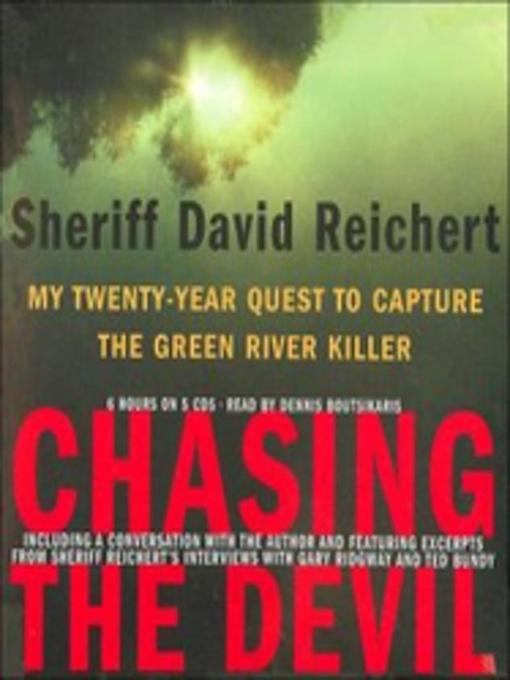
Chasing the Devil
My Twenty-Year Quest to Capture the Green River Killer
فرمت کتاب
audiobook
تاریخ انتشار
2005
نویسنده
Sheriff David Reichertناشر
Hachette Audioشابک
9781594831539
کتاب های مرتبط
- اطلاعات
- نقد و بررسی
- دیدگاه کاربران
نقد و بررسی

Dennis Boutsikaris delivers this story in the same meticulous way that Reichert investigated the Green River murders outside of Seattle. Capturing both the tone and mood of this painstaking investigation, which spanned twenty years, the telling is ideal. This author/narrator combination couldn't be better. Intriguing from beginning to end, Reichert's book reveals the nitty-gritty details of the most horrendous serial-murder spree in U.S. history. Dispersed through the audiobook are actual recordings of Reichert's interviews with Green River killer Gary Ridgeway, after he was captured, and with serial murderer Ted Bundy, whom they interviewed during the investigation in hopes of getting some insight into what the serial killer might do next. This chilling presentation shows how monsters such as these killers can sound alarmingly like regular guys. D.L.M. 2005 Audie Award Finalist (c) AudioFile 2004, Portland, Maine

July 1, 2004
Several years after Ted Bundy's killing spree began in Washington, the deadliest serial killer in U.S. history embarked on a murderous rampage that would remain unsolved for two decades. Both preyed on young women but, while Bundy's victims were often college students, the Green River Killer pursued prostitutes: runaway teenagers and women whose precarious lifestyle, Reichert says, made them easy targets for a murderer. The author, then a homicide detective in the King County Sheriff's Office, was the lead investigator on the Green River case from the beginning, when the bodies of three women were found in and near the Green River in suburban Seattle in August 1982. Twenty years later, DNA testing linked Gary Ridgway to his first victims, and he eventually confessed to killing 53 women. Reichert, by then the county sheriff, finally got to close a case that many thought would never be solved. His absorbing account offers an in-depth look at the obstacles and the frustrations, the leads that went nowhere and the prime suspects who were eventually cleared. In this straightforward, just-the-facts approach, Reichert downplays some of the more sensational aspects that TV has seized on, such as detectives calling on the imprisoned Bundy for help and using an FBI profiler. He illustrates how policing evolved during the course of the case, thanks to new technology, and only occasionally slips into defensiveness. Reichert vehemently stands up for his office, which was constantly second-guessed by the feds, criticized by the press and mistrusted by the victims' families, who thought the police would have made a greater effort to find the killer if the women had been more respectable. A great book for true crime fans, Reichart's account gives readers a chance to see the hard work that went on behind the scenes.

October 4, 2004
Several years after Ted Bundy's killing spree began in Washington, the deadliest serial killer in U.S. history embarked on a murderous rampage that would remain unsolved for two decades. Both preyed on young women but, while Bundy's victims were often college students, the Green River Killer pursued prostitutes: runaway teenagers and women whose precarious lifestyle, Reichert says, made them easy targets for a murderer. The author, then a homicide detective in the King County Sheriff's Office, was the lead investigator on the Green River case from the beginning, when the bodies of three women were found in and near the Green River in suburban Seattle in August 1982. Twenty years later, DNA testing linked Gary Ridgway to his first victims, and he eventually confessed to killing 53 women. Reichert, by then the county sheriff, finally got to close a case that many thought would never be solved. His absorbing account offers an in-depth look at the obstacles and the frustrations, the leads that went nowhere and the prime suspects who were eventually cleared. In this straightforward, just-the-facts approach, Reichert downplays some of the more sensational aspects that TV has seized on, such as detectives calling on the imprisoned Bundy for help and using an FBI profiler. He illustrates how policing evolved during the course of the case, thanks to new technology, and only occasionally slips into defensiveness. Reichert vehemently stands up for his office, which was constantly second-guessed by the feds, criticized by the press and mistrusted by the victims' families, who thought the police would have made a greater effort to find the killer if the women had been more respectable. A great book for true crime fans, Reichart's account gives readers a chance to see the hard work that went on behind the scenes.
Copyright 2004 Library Journal, LLC Used with permission.

























دیدگاه کاربران